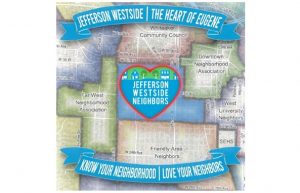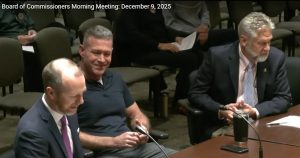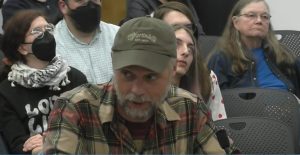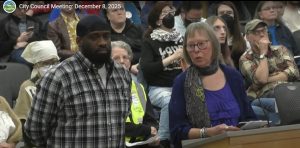Goodbye wildfire season, hello winter weather
12 min read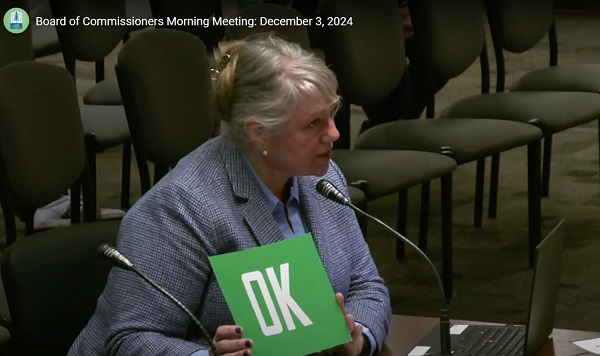
Presenter: As we transition from fire season to winter storm season, commissioners hear a report from Lane County’s emergency manager. On Dec. 3, Tiffany Brown.
Tiffany Brown (Lane County, emergency manager): Goodbye to wildfire season. Hello to winter weather.
Here’s a snapshot of our wildfire season: It began in earnest on July 17th, but I wanted to make a note. Do you remember when the Siuslaw National Forest caught on fire in May? It was really the first indication. I left for the weekend and it caught on fire on a Friday night, and so as I was looking through the red flag warnings, we had a red flag warning as early as February, and so I don’t know what the definition of wildfire season will be moving forward, but it certainly seems to be getting bigger.
[00:00:41] Almost 70,000 acres burned in Lane County; certainly not our largest, necessarily, but it comprised 20 fires and four complexes. I didn’t see a lot of the downstream effects that usually impact emergency management but I certainly walked over and peeked over the edge a couple of times.
[00:01:01] We saw an activation of an animal shelter. That was impressive. We didn’t need it. It was good practice. We didn’t actually activate shelters, and so we came out of it relatively unscathed, with some lessons learned for the next.
[00:01:16] Smoke and air quality tended to stay in the communities that were directly impacted. We didn’t see a tremendous amount down here in the urban areas, which was good. And then we also had a couple heat events during wildfire season. So we really had a few days that were all the things.
[00:01:33] We stand up and start communicating and coordinating early on, but our activities are really downstream, evacuation, needs that occur after evacuation, sheltering and that type of thing. We didn’t see a lot of that activity.
[00:01:47] We only saw a few Level 3 evacuations, the ‘Go now,’ and they were limited in duration. Those are still good to practice. They’re always a nail-biter, even if they only occur for a short amount of time.
[00:02:00] And then we saw evacuation notices go out in residential but also in forest lands up in the (Willamette) National (Forest), getting hikers out and that type of thing.
[00:02:10] We used the alert system a lot this summer. We campaigned ahead of time. We got people signed up. We’ve increased usage. We gave cities an opportunity for their citizens to sign up for city alerts, and we created a new registry page where citizens can self-identify as having a vulnerable status during an event: ‘I may need help with durable medical equipment or evacuation or transportation’ or that type of thing.
[00:02:39] Presenter: Lane County also hosted cooperator calls. Emergency Manager Tiffany Brown.
[00:02:44] Tiffany Brown (Lane County, emergency manager): This is something that we do. It varies in terms of frequency. When things are happening a lot, we have them every day. We settled down to once a week. And that’s simply all of our—some people call them partners. Some people call them stakeholders. We call them and we get on the the call with them and it’s just a great opportunity to share information and have everybody hear the same thing at the same time for us as county staff it keeps us really in a state of operational readiness and it helps our partners develop a muscle for oh it’s time we’re gonna get on the call and find out what’s going on.
[00:03:25] We got good feedback about those. We increased the number of people that called in. Many of you were on those calls on a regular basis, you saw that attendance wax and wane, I think the important thing is that it’s there and people know where to go if they need the information.
[00:03:42] We strengthened this relationship between public health and emergency management. We hosted the cooperator calls on behalf of public health during the heat event, and yes, that was great for our relationship with public health, but I think more broadly, it demonstrates how emergency management can come to the table to support any of our operational partners during an event, whether that be Public Health, Public Works, the Sheriff’s.
[00:04:06] We supported the Elections staff during elections and just was an opportunity to showcase our skills and our abilities and how we can serve one another during events that happen, maybe just interdepartmentally.
[00:04:21] And finally, promoting operational readiness and coordination. People are attuned. The storm, the fire, the cold weather this past week, people are talking about preparedness and I think that’s always a success.
[00:04:37] Presenter: Speaking of cold weather:
[00:04:39] Tiffany Brown (Lane County, emergency manager): We hosted the Army Corps of Engineers and the National Weather Service Weather Outlook on Nov. 18 in the Goodson Room. We invited our community partners to that.
[00:04:51] [We are in store for La Niña this year. The ocean is colder and it magnifies our weather patterns. And for us, that will mean that it will be wetter this year.] The last time that occurred was in 2021. I don’t need to remind you that was the year of some snow in Lane County.
[00:05:12] I was interested to learn that atmospheric rivers really aren’t impacted one way or the other for La Niña El Niño. So we get them regardless, atmospheric rivers are the weather patterns that we associate with the greatest amount of precipitation coming in hard and fast. They don’t last very long—typically only one to three days—but when we think about these historic events that we’ve had they’re often associated with an atmospheric river.
[00:05:40] And the takeaway from our presentation was that when you hear them eight or nine days out, even a week out, it could come or go. It’s when you start hearing about them one to three days that you really need to pay attention.
[00:05:53] Presenter: She described the lessons applied. Tiffany Brown.
[00:05:56] Tiffany Brown (Lane County, emergency manager): We’re looking at the things that we learned last year during the ice storm. We worked on things all summer with respect to those after-actions.
[00:06:04] The first have to do with our Emergency Operations Center which is, you know, arguably our core function as emergency management—how we activate our Emergency Operations Center, how we notify people. The overall feedback that I got during that after-action process was: ‘Where’s the vector? Where do we plug in? And how do we talk to the county?’
[00:06:27] And so that’s what we’ve been working on, and that’s what this works on. And the advent of cell phones, I think it’s so easy, and it’s mobile. But then people change shifts, and they move on, and so we’ve actually got phones that will be set up in the Emergency Operations Center.
[00:06:42] Activation thresholds: We hardened those, and to keep it simple, if any one of our partners activates their Emergency Operations Center, so too will we, whether that’s the utilities or the cities, even a fire district that had a big event within their district.
[00:06:59] I don’t need to remind this group that we encountered challenges and complexities around sheltering specifically with respect to our unhoused system that runs on a regular basis.
[00:07:13] And so we have been working on…development around mass care and public health. I’m meeting with Kate Budd and St. Vincent de Paul to talk specifically about effective interface for the unhoused community in the county Emergency Operations Center this winter.
[00:07:28] And then of course we’re always working to build out the public system. We’re really just focusing on public outreach and education. We always say ‘Yes’ when we’re invited to participate. And the word is out, and we’re getting a lot of requests.
[00:07:42] This is our newest product. It is cleverly named ‘The Help OK Sign.’ And it’s designed for times when responders are few and emergencies are great and boots are on the ground, it saves them maybe a trip up the driveway.
[00:07:59] Imagine this in a mobile home park where someone has responsibility for citizens or a neighborhood where there’s a CERT team. They can distribute these among their citizens and quickly assess the situation, pass by the people who don’t need help to get to the people who do.
[00:08:15] DOGAMI has released new hazard data for Cascadia in Lane County and so we’re retooling a Cascadia presentation because if you’re ready for Cascadia you’re ready for anything.
[00:08:26] Presenter: To be ready for anything, we prepare, plan, train, and exercise. Tiffany Brown.
[00:08:31] Tiffany Brown (Lane County, emergency manager): John Stueve is our new training and exercise coordinator. We have 18 established trainings already on the calendar, a combination of incident command system courses, but also localized courses that help our partners understand how they plug into the EOC, how they request something, how they give a situation report, how they declare in their own community. We’ve been asked by a couple of the non-urban cities to develop senior officials and elected training. That’s exciting.
[00:09:02] And then just helping all of the cities learn how to plug in—those who did it well during the ice storm, how we can help enhance their operations and how we can help other people achieve operational readiness so that we can work together.
[00:09:18] Presenter: Commissioner Ryan Ceniga.
[00:09:19] Ryan Ceniga (Lane County commissioner): So do we know which partners and agencies are all on the same ICS page as the county is, you know, utilities and so on and so forth?
[00:09:30] Tiffany Brown (Lane County, emergency manager): It’s a great question. My husband is fond of saying, ‘Going to law school doesn’t teach you how to be a lawyer,’ and I think that the same holds true for ‘Taking an ICS class doesn’t necessarily teach you how to run an Emergency Operations Center.’
The system was born in the fire service field and so it takes some work to massage it. I think everyone knows it. Everyone has the training. And I think we’re further ahead because we’ve had so much practice at it.
[00:09:59] Ryan Ceniga (Lane County commissioner): Yeah, well, I really appreciate that because being in some of these catastrophes with ICS training, it’s just something that’s as simple as the same language is huge. People understand who they should talk to, who’s in charge of what.
[00:10:13] During the ice storm, I was in the operations center and for one of those was a cooperators call and I was thinking about it while that was happening and just kind of reflecting now is:
If the county is set up, could the county give the different agencies, different utilities, like, during that cooperators call, ‘This is the information we would like.’
Because you listen and you had some great information that was really pertinent to what we were expecting and then you had some other that was kind of what was important to them but maybe not to the entire group.
[00:10:47] Tiffany Brown (Lane County, emergency manager): That’s a great suggestion. You know we have something called the Situation Report that has fields, right, it prompts people. And translating that into the meeting environment is a great idea. Thank you.
[00:11:01] Presenter: Commissioner Heather Buch.
[00:11:03] Heather Buch (Lane County commissioner): One thing that I noted recently regarding Lane Alerts was I was getting alerts that weren’t necessarily in my area and I got confused. So of course, I called our PIO (Public Information Officer Devon Ashbridge) and I’m like, ‘Wait a minute, is this supposed to be happening in our area?’ And it turns out that we get weather calls that aren’t very prescriptive to our district. So the whole area gets a weather call whether it’s at the micro level in our area or not.
And so I was curious about the conversations you may have been able to have.
[00:11:39] The concern I have is not only does it confuse people to get an alert that isn’t relevant to your area, but if they get too many of those, they will disregard the Lane Alert system. And that can’t happen, because when we do want people alerted, we want them to pay attention to the alert that comes on their phone or email or however it goes.
[00:12:01] But I’m hoping that we can have maybe more productive conversations with NOAA or whomever is the weather center to find ways to really tailor those a little bit better. I know we’re missing some weather monitoring in our area that’s pretty serious that I know that our policy team is working on. I’m not sure if that’s directly coordinated to this particular issue, but can you speak on that?
[00:12:27] Tiffany Brown (Lane County, emergency manager): You bet. So Lane Alerts has a function when you sign up that you can sign up to receive weather alerts. And it’s really not, frankly, a very impressive feature relative to the rest of the system. It’s the National Weather Service, when they send out an alert, it just triggers the system. And then the citizens get an alert with a link to that message.
[00:12:50] The frustration about this feature is not new to me, because the alert says the same thing every time. You’re not telling me anything new. National Weather Service, NOAA, all of our federal agencies rely on FIPS codes, which is by county. And so what happened a few weeks ago is that we were getting coastal weather warnings, and I was getting calls from people up the McKenzie irritated that they were getting those calls.
[00:13:15] (Lane County PIO) Devon (Ashbridge) and I talked about either (A) educating people about what it means to sign up for weather alerts or (B) just turning it off. There are better resources for understanding the weather. People that want to hear about the weather can download any number of weather apps.
[00:13:32] The other thing I heard was that somebody had had a silent notification and they got notification in the middle of the night. I also got that and I’ll tell you what that is. The system will honor your after-hours request if it’s a watch but once it turns into a warning it’ll wake you up whether you’ve said to or not.
So yes, thank you, it’s not new, I don’t blame people. I also got them and it is just a quirk in the system that people, I think, think they’re getting something different when they sign up and so we’ll dive into that and improve on that.
[00:14:09] Presenter: Commissioner Heather Buch.
[00:14:11] Heather Buch (Lane County commissioner): In regards to the Help/OK signs, I totally want one. I don’t know how we’re going to get them out to people, but, you know, as complex as what you do when it comes to emergency management, basic is best. That’s the kind of stuff that really works.
[00:14:26] And I can see emergency managers, or even our Public Works group going up and down the road trying to figure out, you know, which places have people and that needs help and which don’t. That can, you know, save a lot of time and energy.
[00:14:38] So I appreciate just the simple gestures that is really what is needed in a crucial emergency.
[00:14:46] Presenter: Commissioner David Loveall.
[00:14:48] David Loveall (Lane County commissioner): The key to us moving forward, I think that you alluded to, but didn’t quite call out, is that that hot-mopping process we go to at the end is really what makes us greater as a community. The thing that I think that kind of struck a chord in me is you said, ‘If we’re prepared for Cascadia, then we’re prepared for anything,’ and I would certainly agree.
[00:15:05] But I think the thing we’re facing is is the amount of preparedness that we estimate we’re going to need. We’re facing a time crunch and a budget crunch and a resource crunch and an infrastructure crunch for our bridges being secure over I-5 to the hospital and all those things that are now popping up on our consciousness that we’re having to deal with. So I’m hoping we have enough time and resources to do that.
[00:15:26] Presenter: Commissioner Laurie Trieger.
[00:15:28] Laurie Trieger (Lane County commissioner): When you mentioned about the sort of activation reciprocity, that if another jurisdiction activates, we do too, just—I mean, that’s wonderful because we can share the information and the resource and we have a capacity and a level of training.
[00:15:41] Presenter: Emergency Manager Tiffany Brown.
[00:15:43] Tiffany Brown (Lane County, emergency manager): We just had a meeting with Oakridge last week and we had a conversation about an entity that activates, that needs help but doesn’t necessarily need that broader help, that we could also move to their organization and just plug in and help with their local operations.
[00:16:00] Presenter: Lane County Emergency Management wraps up the 2024 fire season and looks ahead to a La Niña winter, which is usually a little colder and a little wetter.
[00:16:10] You can prepare for the next winter storm, by printing several Help/OK signs with regular paper on a computer printer, and sharing with your nearby neighbors. This can help direct responders to where they are most needed.
